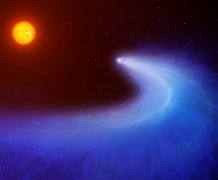
Image courtesy of Mark Garlick/University of Warwick
Giant comet-like tail discovered on small exoplanet
The prospect of finding ocean-bearing exoplanets has been boosted, thanks to a pioneering new study. An international team of scientists, including from the University of Exeter, has discovered an immense cloud of hydrogen escaping from a Neptune-sized exoplanet.
Such a phenomena not only helps explain the formation of hot and rocky ‘super-earths’, but also may potentially act as a signal for detecting extrasolar oceans. Scientists also believe they can use the discovery to envisage the future of Earth’s atmosphere, four billion years from today.
The ground-breaking research is presented in the respected scientific journal, Nature.
Professor David Sing, from the University of Exeter’s Physics and Astronomy department, co-authored the study. He said; “Escaping gas has been seen in the past for larger gas giant exoplanets, so it was a surprise that looking at a much smaller planet resulted in such a big and stunning comet-like display.”
With a mass approximately 23 times that of our Earth located 33 light years away, the exoplanet GJ436b rotates around its star in only three days and has an atmosphere which leaves behind a gigantic trail of hydrogen. Using the Hubble spatial telescope, scientists were able to see this hydrogen cloud’s shadow when it passes in front of the star.
David Ehrenreich, an astrophysicist with UNIGE and lead author of the paper said: “When you’re searching in the visible region you only see the shadow of a planet whose size is equivalent to four times that of Earth like Neptune. But if the sensitive eye is pointed toward the Hubble ultra violet light, the planet is transformed into a veritable monster, far bigger than the star.
“This cloud is very spectacular; it’s as if, after carrying the planet’s atmosphere at a high temperature, causing the hydrogen to evaporate, the radiation of the star was too weak to blow away the cloud that accumulated around the planet.
This evaporation, although spectacular, would not threaten the atmosphere of the exoplanet which was formed several billion years ago. It may, however, explain the disappearance of atmospheres observed on rocky exoplanets, which rotate very close to their star and are extremely hot, such as the famous “super-Earths” discovered by the Corot and Kepler spatial telescopes.
Vincent Bourrier, co-author of the study said this type of observation is very promising in the search of habitable planets since “hydrogen from the ocean water that evaporate on slightly hotter terrestrial planets than the Earth could be detected.”
The phenomenon might even explain the disappearance of hydrogen outside our atmosphere, an element that abounded there more than 4 billion years ago.
Finally, such observations might help to envisage the distant future of our planet, when, in 3 or 4 billion years, the Sun will become a red giant and will circulate in our atmosphere making life impossible on Earth. Astrophysicists now hypothesize that our planet would be transformed into a giant comet, thus resembling a ‘hairy’ star just like GJ436b.
Date: 24 June 2015
